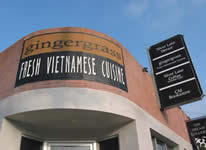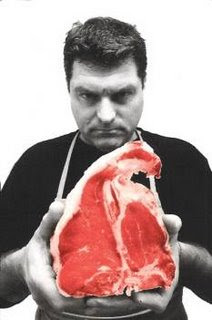
Okay, so it’s been a while since Leslie Brenner “humbly” proposed her diner’s bill of rights in the LA Times’ Food Section. Yes, it’s true, I should be over it by now. I know it has been almost three months since she wrote about restaurant service and what diners ultimately “deserve” when they go out to eat. But the woman was just SO WRONG about what diners should expect from a restaurant and what is considered good service, that even after all this time I am still just-this-close to popping a blood vessel over what she had to say.
Look, I’ve tried to put it out of my mind. Believe me. I’ve probably written something like ten I-can’t-sleep-so-I’ll-craft-an-editorial-response-in-my-mind letter to Brenner herself and sent none of them.
The problem I have with Leslie Brenner the food critic is that she’s lost the joy of being a diner. In my personal opinion, Brenner is fed up with eating out for a living and wants as little to do with the restaurant scene as possible. Her articles show a growing pattern of disdain for what most LA diners would call “helpful service” and her columns show impatience for anything (i.e. service) that gets in her way of immediately sitting down and consuming her food. I bet if you asked Leslie Brenner if she would be interested in going to a beautiful restaurant where she could order her food on a sleek computer screen and receive a perfectly executed meal via a silent robot, she’d give you a big smile and ask if they could set up a standing reservation for her.
Though some of Leslie Brenner’s articles about food are insightful and well written, many of her critical columns about restaurants are devoid of objectivity and are bogged down by her obvious disconnect with the real needs of her readers. Most people that read the Food Section are hungry to learn about food and want information that will lead them to restaurants that they’ll enjoy. She and other old-guard restaurant critics say they should be treated like everyone else, and yet hyper critical of servers for giving descriptions of ingredients commonly asked about. Brenner once wrote critically of a server in a review because he included in a menu description what Burata was. She snidely stated that he was wasting the table’s time because “everyone in LA knows what burrata is”. I’ll have you know, Leslie, that unfortunately not everyone eats out as much as you (or I) do and most people have no idea what half the items are on any given menu. And to prove my point, I counted one night and I found that 9 out of ten tables I serve asks me what buratta is.
Up until now there was a certain level of professionalism that has kept me from writing any letter in response. That and time…this thing is going to go long…When it comes to responding to some of the unbelievably off-base attacks written by food critics, we in the restaurant business tend to keep to a vow of silence out of self-preservation. Sure, we restaurant folk could spend hours talking about all the baloney that’s slung our way, but we adhere to the unspoken understanding that we must maintain a vow of public silence in order to keep off the radar of angry food critics.
I was doing all right holding in my anger, until the other day I discovered the beautifully designed and gorgeously photographed food blog, Matt Bites. In looking through his beautiful photographs, I discovered a very thoughtful response to Leslie Brenner’s article. In it, Matt was critical of Brenner’s call for a sort of “culinary uprising” and wrote about his belief that in order to get good service one must be in the right mind set and be WILLING to get good service. Suddenly I was angry all over again.
Which brings me to the Incredible Hulk.

Despite moments of real frustration over injustice, inequality and bad reporting, I tend to be a really happy person. But if I hold onto my anger and don’t let it out, I tend to turn nasty. Swallowing anger is not only terrible for my personal life, it’s also really bad for business.
So just as the Incredible Hulk learned every week on his hit TV show in the 80’s, I’ve realized that a person (or half man/half monster) just can’t run away from anger. That person (or monster) must face their anger and conquer it.
First things first. I’ve got to put all that anger and frustration with the cock-eyed “bill of rights” down on paper before I really turn green. Who knows if any one else will appreciating my ranting, but god knows I’ll be a much better (and honest) person for doing so. In hopes of honoring Brenner’s initial premise of a diner’s bill of rights, I humbly suggest we add a few points, take a few away and lastly, do a LOT of editing.
1. Hospitality.Early in her bill of rights, Brenner waved the Danny Meyer flag of what is good service. She quoted his book “Setting the Table” with “hospitality exists when you believe that the other person is on your side.” I believe that getting great service at a restaurant requires the server and the diner to agree that they are entering into a business transaction* in which both people are required to give one one another respect and attention. A nasty server is no more accommodating than a guest with a bad attitude. Just as a server must show individual consideration to each guest and their needs, a diner must walk in the door with an open mind (and receptive stomach).
2. Restaurants are a business: I felt it was important to add this one because more and more I find that on average, most guests forget this. They ignore posted business hours (“what do you mean you can’t open 30 minutes early? My kid’s hungry!”, the lounge at tables for hours (“we’re catching up!”), bring in their own food (“look at the pretty cookies Grandma made!”) and get upset when we charge a “cake cutting fee”. Even though restaurants serve food and must offer good service, guests must realize that restaurants are a business. Tables have budgeted times, each restaurant has a set culinary style (i.e. don’t ask the sushi chef to cook you up some nice tuna), food is portioned and employees are paid minimum wage (however, in NY and Massachusetts, servers are paid less than half the minimum wage). Restaurants are not picnic stands and are not non-profit organizations. Just as a bank, hotel or retail store have certain rules (hours of operation, intolerance of thievery, procedures and protocols), so does a restaurant. Respect them.
3. Equal opportunity. “Restaurants shall not show preference in granting reservations to celebrities or their handlers.” Leslie’s words and I couldn’t agree more. However, her preposterously broad statement that “each di
ner has an equal right to any given table,” is ludicrous. If every two people that walked into a restaurant and demanded the equal right to sit at a table for six, than nearly every family dinner out or birthday celebration would be ruined.
3. Time of your choice. “You shall be given a reservation at or near the time you prefer when the restaurant has tables available. The corollary is that if you cannot show up, you shall cancel the reservation in a timely fashion.” Again, Leslie’s words. It should be mentioned that since empty tables drive customers mad, all diners showing up more than 15 minutes late (without a phone call) should not only be considered a no-show but they, the late customer, will take responsibility for their tardiness and not point blame elsewhere. Like missing a flight or a movie or any other business that runs on a time schedule, the customer pays the price for showing up late. Not the business.
4. Timely seating. When you arrive on time, you shall be seated on time. I agree with this idea as much as I agree with the philosophy of “paying it forward”. But if a diner expects to be seated on time, the diner will respect those who come after them and not sit at the table for an hour after the food is done so that they can “catch up.”
Restaurants budget between an hour to 2 hours (depending on the style of service) per table and book their rooms accordingly. Making other diners wait because you want a place to hang out is unfair. For clarity, see “Restaurants are a business” above.
5. Courteous greeting. “You have the right to be greeted courteously at the door.” Absolutely. Good service is all about good manners. So when a server says hello and greets the diners, the diners will have the common decency to respond with a look or a hello back.
6. Waiter’s anonymity. You have the right not to be told your server’s name.
I’m sorry, Leslie. I can’t even start to understand this rule. This one would make sense if we were talking about a firing squad.
Servers don’t want to be your friend. They appreciate being seen as human. Surely even Jeeves, the manservant, was allowed a name.

In the words of Bruce Banner just before turning into the incredible Hulk, “Don’t make me angry. You wouldn’t like to see me when I get angry.
7. Wait at the table. Brenner believes that guests that “arrive at the time of your reservation and (the) table is ready, you shall be promptly seated, and not asked to wait for your party to be complete.” Not a bad idea if diners that are unwilling to wait for their party to be complete are respectful of the other diners with reservations following their dinner. If the diner’s reservation is for 7 o’clock and the table is needed back by 9, the diner will respect the restaurant’s need to sit the following guests in a timely manner.
8. Know your restaurant. Thought this was a good one to add. If you (or any of your fellow diners) don’t like meat, dairy, wheat or loud music at restaurants—don’t go to a restaurant that offers those things. If you think $30 is too much to pay for an entrée, don’t go to a restaurant that serves $30 entrees. If someone is willing to go to said restaurant despite their aversion to one or all of the above issues, they must either be willing to compromise or able to suspend judgment of said restaurant. Because let’s be honest, a person with wheat allergies in a noodle house, no matter how hard the restaurant tries to make the diner-with-restrictions happy, will not be experiencing an optimal dining experience. If a diner doesn’t like rock and roll and steak, they shouldn’t go to a rock and roll steak joint. Like any business, restaurants choose to do things a certain way for a reason. If you don’t like it, do go there. Save your money for another restaurant. No one is forcing you to eat out.
9. Tell it like it is. Brenner states that diners “have the right to a simple, accurate description of any dish you ask about.” The corollary to this clause should be noted that no food critic will criticize a server for describing an ingredient because they personally believe that everyone knows what “burratta” is.
10. Right of refusal: wine. Brenner is right when she says that “you have the right to refuse a wine that is not in good condition, and you shall not be required to pay for it.” If, however, you order a wine that isn’t corked, don’t feel it’s your inalienable right to change your mind twenty minutes (and ½ a bottle) later when all the glasses have been poured and your friends tell you they don’t like (your choice in) the wine.
So I ask you Leslie Brenner, with the list of demands minimized and reality balanced with expectations, do you think you could abide by these rules? True, the job of a restaurant critic is a difficult balance. One must be a talented writer, an educated diner and have an unflinching critical eye. But after years of eating out every day and writing about restaurants, there’s got to be more for you than getting through the meal so you can soon grind your axe at the newspaper. If you want to have a great experience at a restaurant (or in anything in life for that matter), you have to walk into it with a positive attitude and an open mind. Great restaurant experiences don’t just happen TO you.










